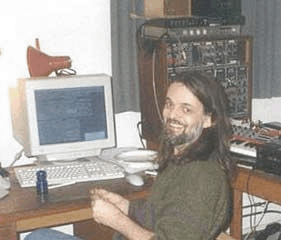 Jan Punter / Nord Modular
Jan Punter / Nord Modular Jan Punter / Nord Modular
Jan Punter / Nord Modular
by Per Vilez

Jan Punter is an experienced Nord Modular who develops intricate 'noodles'. He also has developed some very useful PC programs which processes and generate MIDI data using a sets of modules. To this effect his software 'MIDIMod' is not dissimilar to the Nord Modular concept.
Jan took some time out to talk about his software and his Modular 2002 installation 'Work-34'.
Per Vilez:
MidiMod is unique in that by putting together various MIDI processing modules one can generate complex midi data constructs. How does this affect the musical composition process?
Jan Punter:
MidiMod never was a starting point for me. Basically what I really want to do is make self playing patches on a modular synthesiser. But it's quite easy to run out of resources that way, whilst still a little extra modulation or variation could be desirable. This is the reason I created MidiMod, to be able to modulate Nord Modular patch parameters through MIDI, to get a little extra dynamics.
Per Vilez:
Is the MidiMod built to compliment the audio signal generation aspects of the Nord Modular?
Jan Punter:
Yes that was the reason for its coming to existence. During the years I have had my Nord Modular I have learned to make better use of it's modules capabilities. With a bit of puzzling it's often possible to use one module for more than one specific purpose.
Per Vilez:
Can you tell us more about Noodling on the Nord Modular?
Jan Punter:
A complete answer would take a lifetime. I will tell you, however, about the basic ideas that drive me to Noodle on the Nord modular.
For me a noodle is a self playing patch which has the property that it is not too static and not too chaotic. Both extremes are pretty boring to me, yet for me, somewhere in between something seems to happen which makes it come alive.
What I basically do is try to find a way between order and chaos in the elements of music: rhythm, tempo, volume, timbre, pitch, scales etc. The Nord modular synthesiser offers all kinds of tools. A simple sequence would not be very exiting, but when two sequences are used in which a random selection is made between the two, things start to come alive. One oscillator has a sound that is static, however, when feedback (AM or FM) is applied it will, at a certain feedback level, start to make a more complex, more dynamic sound.
Ideally one would like to do this on a real analogue synthesiser. Such a synth has intrinsic imperfections. They have a certain level of randomness which tends to make things interesting. On the Nord Modular small (semi) random variations can be programmed into the feedback loops to make a patch (in effect a calculations) surf through it's (semi) chaotic states.
I know that theoretically a lot can be said about subjects like these, but the truth is that I compose my noodles in a rather intuitive way. I didn't receive any theoretical education in the fields of electronics or computer science, and I am sure that this probably helps to guide my intuition. The final result however, is the most important thing. If I connect a cable and it produces an interesting result, I don't really care if it is theoretically correct.
Per Vilez:
Can you tell us something about the noodle installation titled 'Work 43' which you are presenting at Modular2002?
Jan Punter:
For 'Work 34' I chose to use a specially written program that simply sequences through a preset list of patches, all in a precisely timed manner. It could be written using a program like QBase. The program does a fade-in from one set of self playing patches on one synth, meanwhile another synthesiser fades out and changes it's patches and then fades in and so on.
The patches themselves are not totally predictable, so if the performance were to be repeated it would be slightly different each time.